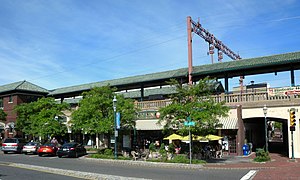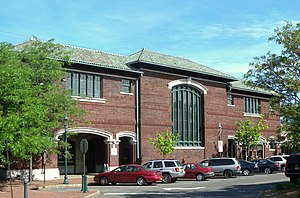
The Morristown Line is an NJ Transit commuter rail line connecting Morris and Essex counties to New York City, via either New York Penn Station or Hoboken Terminal. Out of 60 inbound and 58 outbound daily weekday trains, 28 inbound and 26 outbound Midtown Direct trains use the Kearny Connection to Penn Station; the rest go to Hoboken. Passengers can transfer at Newark Broad Street or Summit to reach the other destination. On rail system maps the line is colored dark green, and its symbol is a drum, a reference to Morristown's history during the American Revolution.

Newark Broad Street station is a New Jersey Transit commuter rail and light rail station at 25 University Avenue in Newark, New Jersey. Built in 1903, the station's historic architecture includes an elegant clock tower and a brick and stone façade on the station's main building. In June 1984, the station was added to the National Register of Historic Places in recognition of its historical significance.
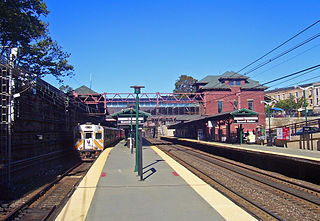
Summit is a train station in Summit, New Jersey, served by New Jersey Transit's Morris & Essex Lines. The station sits between Union Place on the north and Broad Street on the south, with station access via either side, and between Summit Avenue on the east and Maple Avenue on the west. Constructed in 1904–1905 by the Delaware, Lackawanna and Western Railroad in a mile-long open cut, it is one of the few NJ Transit stations with platforms below street level.

East Orange is an active commuter railroad train station in the city of East Orange, Essex County, New Jersey. Located next to East Orange City Hall, the station serves trains on the two lines that make up New Jersey Transit's Morris and Essex Lines: the Morristown Line and Gladstone Branch. Trains heading east to New York Penn Station and Hoboken Terminal stop at Newark Broad Street Station next, while trains heading west towards Gladstone and Hackettstown stop at Brick Church station. East Orange station contains two platforms to service three active tracks. The station is accessible for handicapped persons per the Americans with Disabilities Act of 1990.

Brick Church is an active commuter railroad station in the city of East Orange, Essex County, New Jersey. The station, one of two in East Orange, is located next to the Temple of Unified Christians Brick Church, designed with brick architecture. The other station, located 0.6 miles (0.97 km) to the east, is the namesake East Orange stop. Trains from the station head east on New Jersey Transit's Morristown Line and Gladstone Branch to New York Penn Station and Hoboken Terminal while westbound trains service stops out to Gladstone and Hackettstown. Like its sister station, Brick Church contains three tracks and two platforms. However, it is not accessible for the handicapped.

Orange is an active commuter railroad train station in the city of Orange, Essex County, New Jersey. One of two stops in the city, it is served by New Jersey Transit's Morris and Essex Lines: the Morristown Line to Hackettstown and the Gladstone Branch to Gladstone for trains from New York Penn Station and Hoboken Terminal. Orange station contains two low-level side platforms and three tracks.

Highland Avenue is an active commuter railroad station in the city of Orange, Essex County, New Jersey. One of two in the city, along with the eponymous Orange station, Highland Avenue is serviced by trains of New Jersey Transit's Morris and Essex Lines: the Morristown Line and Gladstone Branch. Trains through the station run between New York Penn Station and Hoboken Terminal to the east and Hackettstown and Gladstone. The station contains two low-level side platforms for the three tracks that run through the station.

Mountain is a New Jersey Transit station in upper South Orange, Essex County, New Jersey, United States, along the Morris and Essex. The station, built in 1915, was designed by Frank J. Nies. It has been listed in the New Jersey Register of Historic Places and National Register of Historic Places since 1984 and is part of the Operating Passenger Railroad Stations Thematic Resource.

Maplewood is a train station that serves New Jersey Transit's Morristown Line and Gladstone Branch in the township of Maplewood, Essex County, New Jersey. Located in "The Village" in Maplewood at 145 Dunnell Road, the station services trains from New York Penn Station and Hoboken Terminal to the east along with trains to Summit, Dover, Hackettstown and Gladstone to the west.

Short Hills is a New Jersey Transit train station in Short Hills, New Jersey along the Morris & Essex Lines.
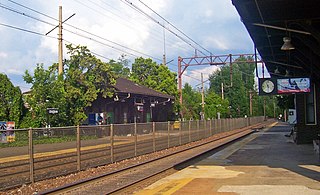
Chatham is a railway station in Chatham, New Jersey. A commuter rail station, Chatham receives rail service from statewide provider NJ Transit on its Morristown Line, a branch of the Morris & Essex Lines. Trains on the Morristown Line go to both Hoboken Terminal and New York Penn Station.

Madison station is a NJ Transit station in Madison, New Jersey. It is located on the Morristown Line.
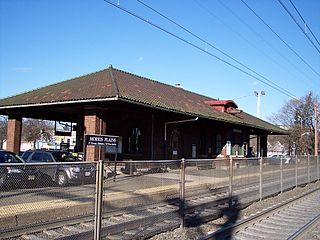
Morris Plains Station is a NJ Transit station in Morris Plains, in Morris County, New Jersey, United States, along the Morristown Line at Route 202 in downtown Morris Plains. It is a local station.

Mount Arlington is a commuter railroad station for New Jersey Transit. Located in the borough of Mount Arlington, Morris County, New Jersey, United States, the station is located next to interchange 30 on Interstate 80. The station serves as a park-and-ride for commuters to catch trains for Hoboken Terminal and New York Penn Station. Trains use the Montclair-Boonton Line and Morristown Line to serve locales between Hackettstown and the eastern terminals. Lakeland Bus Lines also services Mount Arlington station. The station is handicapped accessible as part of the Americans with Disabilities Act of 1990. The station features two side platforms and two tracks with elevators.
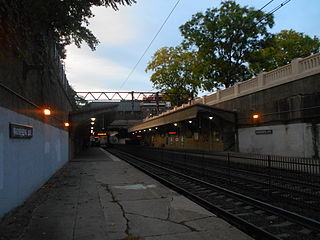
Watsessing Avenue station is a New Jersey Transit rail station in Bloomfield, New Jersey, along the Montclair-Boonton Line. It is located beneath the Bloomfield Police Benevolent Association meeting hall near the corner of Watsessing Avenue and Orange Street in Bloomfield. It is one of two stations on the line where the boarding platform is below ground level. The Watsessing station and the Kingsland station in Lyndhurst on the Main Line shared similar designs and were built about the same time.

Lincoln Park is a station on NJ Transit's Montclair-Boonton Line in the borough of Lincoln Park, Morris County, New Jersey. The station is located near the Comly Road overpass, accessible from Main Street, Station Road and Park Avenue.
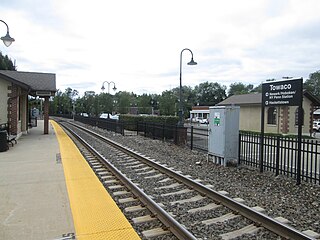
Towaco is a station on NJ Transit's Montclair-Boonton Line located between U.S. Route 202 and Whitehall Road in the eponymous neighborhood of Montville Township, Morris County, New Jersey. The station opened as Whitehall in 1870 along the Boonton Branch of the Delaware, Lackawanna and Western Railroad, and assumed its current name in 1905.

Roseville Avenue was a transfer station on New Jersey Transit's Morris & Essex Lines in Newark, New Jersey, United States. The station was built by the Delaware, Lackawanna and Western Railroad in 1903 as part of a project to lower the tracks below the road surface to eliminate grade crossings. It serviced Newark's Roseville neighborhood. It once had two tracks on the Lackawanna mainline and two low-wall platforms, with an additional platform along the Montclair Branch. The station remained in service during most of the 20th century, until New Jersey Transit closed the station on September 16, 1984.

Kingsland is a railroad station on New Jersey Transit's Main Line. It is located under Ridge Road (Route 17) between New York and Valley Brook Avenues in Lyndhurst, New Jersey, and is one of two stations in Lyndhurst. The station is not staffed, and passengers use ticket vending machines (TVMs) located at street level to purchase tickets. The station is not handicapped-accessible. Originally part of the Delaware, Lackawanna and Western Railroad's Boonton Branch, the current Kingsland station was built in 1918.

The Montclair-Boonton Line is a commuter rail line of New Jersey Transit Rail Operations in the United States. It is part of the Hoboken Division. The line is a consolidation of three individual lines: the former Delaware, Lackawanna & Western Railroad's Montclair Branch, which ran from Hoboken Terminal to Bay Street, Montclair; the Erie Railroad's Greenwood Lake Division, which originally ran from the Erie's Jersey City Terminal to Greenwood Lake, NY; and the former Lackawanna Boonton Line, which ran from Hoboken to Hackettstown, New Jersey. The Montclair-Boonton line was formed when the Montclair Connection opened on September 30, 2002. The line serves 28 active rail stations in New Jersey along with New York Pennsylvania Station. It crosses through six counties, serving six stations in the township of Montclair, two in the town of Bloomfield, and one in the city of Newark. Trains along the Montclair-Boonton Line heading eastward usually originate at Hackettstown, Mount Olive, Lake Hopatcong, Dover, or Montclair State University, bound for either Hoboken Terminal or New York Penn Station. On system maps the line is colored maroon and its symbol is a bird, after the state bird, the eastern goldfinch.
